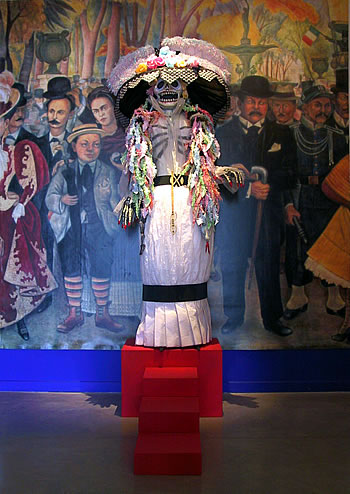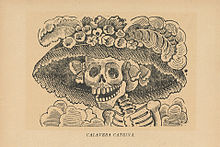Day of the Dead Bread
This is a simple sweet bread, with anise seeds added for bitterness, often dusted with sugar for sweetness. In Isla Mujeres you will find them among the baked goods at the Super San Francisco in the couple weeks preceding Día de los Muertos, celebrated on November 2. Individual vendors will also be selling them. A soft bread shaped like a bun, it is usually decorated with bone-like pieces. As part of the celebration, loved ones eat pan de muertos as well as the relative's favorite foods. The bones represent the lost one (difuntos or difuntas) and there is often a baked tear drop on the bread to represent sorrow. The bones are positioned to portray the circle of life. This is a typical pan muertos, above.

 This pan de los muertos was made by a norteamericana. This apron is from Mexican Sugar Skull as is the paper mache skull below.
This pan de los muertos was made by a norteamericana. This apron is from Mexican Sugar Skull as is the paper mache skull below.
Her face is unforgettable and she goes by many names:
La Catrina (Fancy Lady), La Flaca (Skinny), La Huesuda (Bony), La Pelona (Baldy).
A fixture in Mexican society, she's not some trendy fashion model, but La Muerte — Death.
La Catrina

 Created 101 years ago, her name was "Calavera Catrina or Garbancera" (by José Guadalupe Posada) as the figure at left. Calavera means "skull", Catrina is her name, and Garbancera refers to a Mexican who identifies with her European ancestors, while denying her local heritage, culture, or race. The more recent version at right is by Diego Rivera. She is mischievous, and flirty, with a sense of fun, while representing Death.
Created 101 years ago, her name was "Calavera Catrina or Garbancera" (by José Guadalupe Posada) as the figure at left. Calavera means "skull", Catrina is her name, and Garbancera refers to a Mexican who identifies with her European ancestors, while denying her local heritage, culture, or race. The more recent version at right is by Diego Rivera. She is mischievous, and flirty, with a sense of fun, while representing Death. La Flaca (Santa Muerte)
La Flaca, or the Skinny One is also called Santa Muerte, who often carries a scythe and a globe, or other objects, and wears a long robe. She is a type of religious figure, with a cult following. While this is condemned by the Catholic Church, some estimates indicate followers may have grown by over 2 million in the past decade. Depending on which history you read, this cultish worship began in the mid 1940's, or in the 1960's. Other names for La Muerte:
| Photo taken in Isla Mujeres. |
La Calaca--A skeleton or skull representation often including marigolds, that is usually a playful depiction, in festive clothing with musical instruments, celebrating the joyous afterlife. I really like the scene in the movie "Frieda" where Calacas portray the docs & nurses after her accident. People collect these whimsical figures.
La Pelona--Baldy
 Calaveras de Azucar--Sugar skulls, which can be intricate when made by hand. This tradition comes from Europe. Celebrating with your departed relatives is considered an indigenous custom.
Calaveras de Azucar--Sugar skulls, which can be intricate when made by hand. This tradition comes from Europe. Celebrating with your departed relatives is considered an indigenous custom.

No comments:
Post a Comment